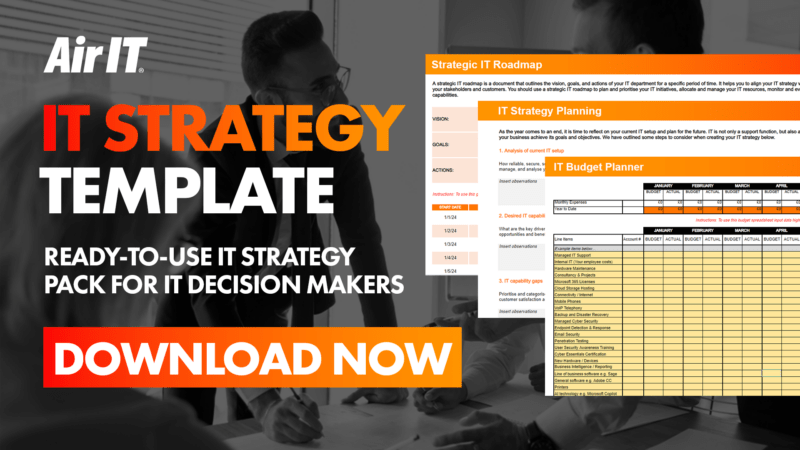With the new year coming up, it's the perfect time to rethink how your business can use technology to grow, innovate and succeed. IT isn't just about fixing issues; it's a roadmap to make you more competitive. Below, we have outlined essential steps to assist in shaping an IT strategy that leads to success.

A well-planned and effective IT strategy will give you the confidence to plan your IT investments in a way that improves your organisation and protects your business.
Producing a successful IT strategy takes careful planning, but with the right guidance and some simple tools, it’s not as hard as you think. Below, we’ve listed the critical steps and considerations for developing a robust IT strategy and produced a set of tools to guide you through the process.
Step 1: Analyse your current IT setup
Before planning for the future, it’s essential to understand your current IT landscape. This includes identifying its strengths, weaknesses, and alignment with business goals.
- Reliability, scalability, and cost-effectiveness: Are your systems stable and capable of supporting growth cost-efficiently?
- Support for business processes: How well do your IT applications align with and enhance your operations?
- Data management: Are you effectively collecting, storing, managing, and analysing data?
- Operational efficiency: Are your IT processes agile, effective, and efficient?
Step 2: Define your desired IT capabilities
The next step is to define your desired IT capabilities for the year, aligning your IT objectives with your business vision.
- Key trends and drivers: How will advancements in AI, blockchain, IoT, and sustainable technology impact your business?
- Challenges and risks: What threats, such as cybersecurity risks, need to be mitigated?
- Opportunities and benefits: Which new markets or efficiencies can you unlock with technology?
- Core competencies: What new skills, systems, or processes will your IT team need to develop?
Step 3: Identify and prioritise IT capability gaps
Determine where your current IT setup falls short of your desired state and prioritize these gaps based on:
- Business impact: How significantly does the gap affect performance and customer satisfaction?
- Urgency: How quickly must the gap be addressed to avoid disruptions or missed opportunities?
- Resources required: What time, budget, and expertise will you need to close the gap?
Step 4: Develop your IT investment plan
Turn your insights into an actionable investment plan. Outline:
- Initiatives and actions: What projects will address the identified gaps?
- Expected outcomes: How will these initiatives improve operations, customer experience, or profitability?
- Timeline: When will these projects start and finish?
- Budget: What are the costs, and what ROI can you expect?
- Stakeholders: Who will lead and support these efforts?
Key considerations for your IT strategy
The above steps can help you create a strong and strategically aligned IT framework that can effectively meet the demands and take advantage of the opportunities in 2025. However, it is important to keep in mind a few key factors while developing your IT strategy:
- Stay up to date with technology trends: It is crucial to keep up with the latest technological advancements to identify new opportunities and stay ahead of the competition. Technology is constantly evolving, some of the key technology trends to watch out for in 2025 include AI, sustainable technology, blockchain, and IoT.
- Prioritise cyber security: As technology advances, cyber threats are becoming more complex and sophisticated, posing greater risks to organisations worldwide. Therefore, having a robust cyber security strategy in place is crucial. Traditional firewalls and antivirus software are no longer able to keep up with the pace of change or the sophisticated tools that cybercriminals are using. Consider implementing EDR and Managed SIEM for a robust defence.
- Scalability and flexibility: It is important to create systems and processes that can expand with your business needs and adapt easily to changes in technology and operations.
- Embrace the cloud: Cloud computing is becoming increasingly popular due to its range of benefits, including increased flexibility, scalability, and cost savings. As you build your IT strategy for 2025, consider how you can leverage the cloud to achieve your business goals.
- Stakeholder collaboration: Involving key stakeholders helps to align the IT strategy with your wider business goals and objectives, ensuring that the strategy caters to different functional needs.
- Vendor selection: By identifying and partnering with vendors whose offerings align with your business’s needs, goals, standards, and budget, organisations can gain a competitive edge, reduce risks, enhance service offerings, and access specialised expertise.
- Review and adapt: It’s important to regularly review and adjust your IT strategy based on feedback, emerging technologies, and changes in the business landscape.
- Disaster recovery and business continuity: Include strategies for disaster recovery and maintaining business continuity in case of IT failures or cyber attacks.
Measuring the success of your IT strategy
Ensure you have clear metrics to evaluate your IT strategy’s performance. Consider tracking:
- ROI on IT investments.
- Improvements in operational efficiency.
- Reduction in system downtime.
- Security incident rates and response times.
Get started on your 2025 IT strategy today
The pace of technological change is accelerating, and businesses must be proactive in adapting to stay competitive. With the right IT strategy, your organisation can unlock new opportunities, improve efficiency, and build resilience.
Download our ready-to-use IT strategy template pack that enables you to build a clear and coherent IT strategy that aligns with your wider business goals and objectives. If you need assistance with implementing an effective IT strategy, please don’t hesitate to get in touch.





